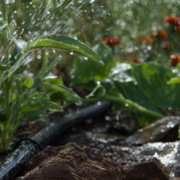Whether you are excited about an extra hour of sleep or dour about losing an hour of sunlight at the end of the day, daylight saving time ends Sunday, Nov. 4. The annual adjustment is a great reminder to perform several important household tasks, such as replacing smoke alarm batteries and restocking emergency preparedness kits.
The San Diego County Water Authority asks residents to add one more important task when changing the clocks: Adjust irrigation systems to save water in the months ahead.
“Adjusting irrigation is an easy way to conserve water, since landscapes need less irrigation as the days get shorter and cooler,” said Dana Friehauf, a water resources manager for the Water Authority. “Residents also should make sure their irrigation systems are working correctly, and are free of broken sprinkler heads or other leaks that waste water.”
Approximately half of a typical California household’s water use is outdoors. Seasonal adjustments to irrigation controllers in preparation for winter weather not only reduce water waste, they benefit the health of landscape plants.
Cool-season water-saving practices can reduce use
Additional water-saving practices during the fall and winter months include:
- Turning off irrigation systems when rainstorms are predicted.
- Leaving irrigation systems off for at least a week after significant rainfall.
- Installing rain barrels or cisterns to help capture stormwater from roofs and store it for future irrigation use.
Fall is also the ideal time for residents to upgrade thirsty turf yards to WaterSmart sustainable landscapes. Homeowners can take advantage of winter rains to help establish a new landscape. The Water Authority’s award-winning WaterSmart Landscape Makeover Program offers a variety of free classes and how-to online videos to guide homeowners through the conversion process. More information is at WaterSmartSD.
In addition, there are a limited number of residential rebates available for homeowners who want to upgrade to sustainable landscaping at SoCal Water$mart.
The Water Authority offers additional water-saving resources for residents and businesses through its Live WaterSmart campaign. These include:
- Free water-use surveys and irrigation checkups
- Rebates for highly efficient irrigation equipment, washing machines and other devices
- Water-efficiency training for professional landscapers
- An online home water-use calculator and other tools
For a comprehensive list of tips, or to learn more about the Water Authority’s suite of water-saving resources, go to WaterSmartSD.org.



